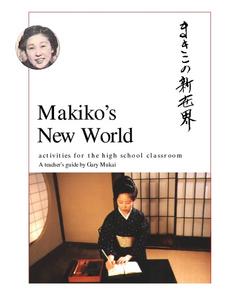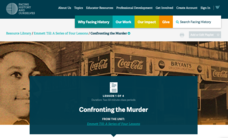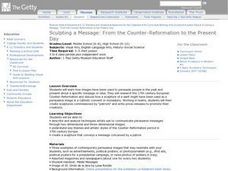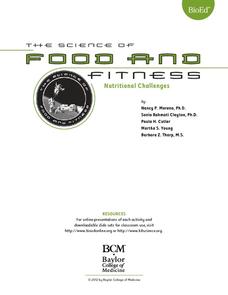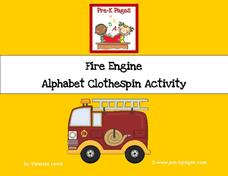Curated OER
How We See Things
Students study light. In this lesson on light, students discuss how flat and angled mirrors reflect light and draw a picture showing how a mirror reflects light into an eye.
Curated OER
Introduction to the Day and Night Sky
Students explore space science by participating in a sky observation activity. In this astronomy activity, students define a list of astronomy vocabulary terms and examine star charts of the four seasons. Students gather with their...
Curated OER
Makiko's New World
Students analyze the internal and external causes of the Meiji Restoration. They look at the goals and policies of the state and their impact on Japan's modernization. Students also assess the impact of Western ideas on Japan and realize...
Facing History and Ourselves
Emmett Till: Confronting the Murder
The 1955 murder of Emmett Till is often regarded as the catalyst for the Civil Rights Movement of the 20th century. Learn more about the brutal crime—and, as many believe, the miscarriage of justice—that began a national conversation...
Newseum
E.S.C.A.P.E. Junk News
Fair, balanced, and reputable information? There's an acronym for that! Scholars learn the E.S.C.A.P.E. method for evaluating news sources. Then, pupils work in small groups to read and analyze a news story and discuss the activity to...
Curated OER
Metrically Me!
Young scholars define the parts of a database, search strategies to locate information electronically, create/modify databases, etc. and enter data into a prepared spreadsheet to perform calculations.
Baylor College
Milestones in Microbiology
Life science learners read a set of six short Discovery Readings that describe historical events in the field of microbiology. For each, they identify clues about when the event occurred and then they try to arrange events in...
Baylor College
Post-Assessment: And Now, What Do You Know About Microbes?
Your life science class works in their groups to review the concept maps that they have constructed over the course of a microbiology unit. They share what they have learned with the rest of the class. In a second session, they are given...
Baylor College
Defending Against Microbes
In the preceding instructional activity from the unit, beginning biologists discovered that microorganisms are everywhere, so the question follows, why are we not sick all of the time? Class members read and discuss an article in small...
Curated OER
The Changing Landscape
Young scholars examine the evolution of landscape painting in France from the 17th to the 19th century. They study and compare three landscape paintings, emphasizing space, depth, and the concepts of foreground, middle ground, and...
Curated OER
Tracing the History Of Food
Students explore cultural variations in food preparation. They pick a country and research dishes of cultural significance. They prepare their food and present the dish to the class creatively.
Curated OER
Translating Science Into Public Policy
Students role-play participants at a panel on climate change. They represent either scientists or policymakers. "Scientists" use the information they've learned in other classes and assignments to present information to "policymakers,"...
Curated OER
Dual place names in Australia
Students discuss landmarks commonly found on maps. They are divided into two groups, and asked to draw a map for a friend who hasn't been to the area. Group A may use street and place names, group B may not. Students discuss the role of...
Curated OER
Messages in Art Work
Observe images and discuss what messages they convey. In this critical thinking lesson plan, students determine whether works of art are trying to persuade their audience. They also consider the media and how they communicate messages to...
Curated OER
Naturalized Citizens and the Presidency
Students consider the presidential requirements. In this U.S. Constitution lesson, students participate in a role play that requires them to act as senators and debate an amendment to allow naturalized citizens to run for the presidency.
Curated OER
Sculpting a Message: From the Counter-Reformation to the Present Day
Students discuss persuasive messages in art. In this art history lesson, students research 17th- century European sculptures to find the messages given. They create their own sculptures and write press releases to explain their art.
Curated OER
Grow Your Own Grub
Students create a recipe book. In this produce lesson plan, students watch a selection of the harvest animations from the BBC Dig In website, taste some of the vegetable and herbs they've been growing and discuss creating a class...
Baylor College
Microbes and Disease
Discuss how diseases have impacted human history. Divide your class into groups and assign each group one of the following: tuberculosis, malaria, plague, cholera, smallpox, and AIDS. They read up on, complete a concept map, and present...
Baylor College
Calculating Exponential Growth
There can be a steep learning curve when teaching about exponential growth, but the lesson helps kids make sense out of the concept. When talking about exponential growth of viruses, learners may not be very interested, but when you are...
Baylor College
Modeling an HIV Particle
Models are an important part of science; they help us see the world on a scale that works for us. In the first of five lessons on HIV, learners make a paper model of the HIV virus that is about 500,000 times larger than the actual virus....
Baylor College
HIV/AIDS in the United States
In the final of five lessons about HIV/AIDS, groups create presentations to share data about the infection rates in the United States, examining demographic and geographic trends over the past ten years. Depending on how much time you...
BioEd Online
Arm Model
Arm your young scientists with knowledge about anatomy as they build their own model of the elbow joint. Help them get a firm grasp on how muscles and bones interact to allow movement as they try different positions for the muscles on...
BioEd Online
Nutritional Challenges
Eating healthy can be a challenge, especially for people with special dietary needs. After learning about standard nutritional needs for adults, learners take on the role of a dietician and work together to create a menu for one of the...
Pre-k Pages
Fire Engine Alphabet Clothespin Activity
Weeoou weeoou! What's that sound? It's the alphabet fire truck! Cover the letters of the alphabet and fire engines with a fun letter-matching game.


